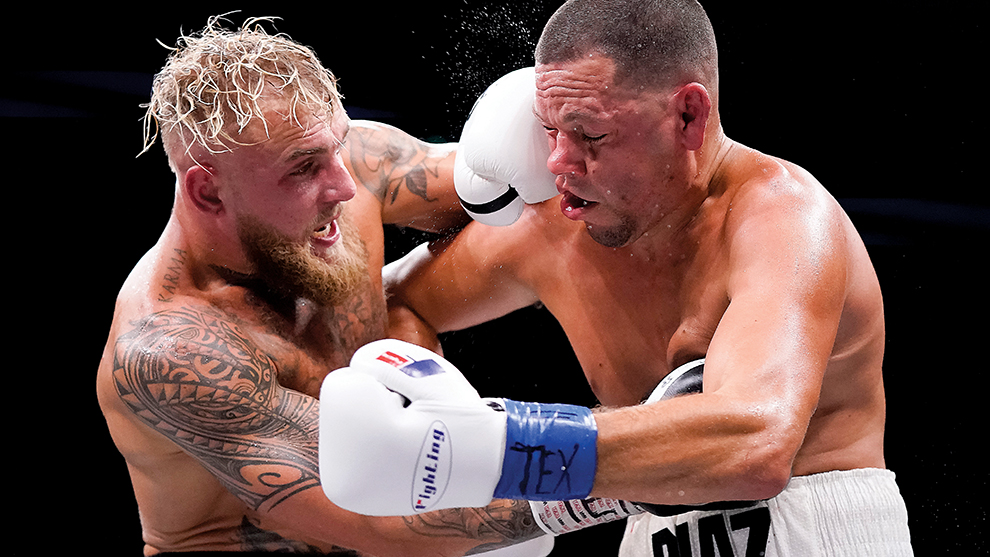Websites
IN A MARKET fuelled not by a meritocracy but rather a race for attention, boxing is stuck in limbo. Even at the best of times, the sport doesn’t know how to market itself, but that is especially true in this era of so-called “crossover boxing.” That is what DAZN – the broadcaster who has embraced this genre more than any other – calls fights like Jake Paul vs Nate Diaz.
But is it a separate brand, or is it just boxing? If you ask Mike Tyson, one of the most recognisable faces to have ever laced up a pair of gloves, Paul is not only a legitimate boxer but he is going to “save boxing.”
That question is boring, though. We’ve asked it a thousand times over the past few years and no one has a definitive answer. If you ask Paul what his job is – and many have – he will tell you without a shred of irony that he is a “pugilist.”
And because of the attention he inexplicably commands, no one bats an eye when he says that. Boxing didn’t just allow him through the door, it begged him to stay. His events generate millions of dollars in revenue and there is no shortage of folks involved in the sport who will line up to work with him and his team.
And now the sport is having an identity crisis. When he fights, and this weekend was no different, Paul dominates the headlines. Whether it’s national news outlets or fringe boxing sites, there are countless articles, features and opinion pieces written about him and this new version of boxing he has become the unofficial king of. The reason is simple: money.
Regardless of sentiment, Paul attracts attention and so webpages about him will attract traffic, which in turn equates to revenue through advertising and such. It’s the same reason Paul decided to give boxing, the most capitalist sport in existence, a go in the first place.
And it’s the same reason most coverage of boxing focuses on its oddities and outrages. The sport, in its current state, cannot maintain that level of attention purely on merit. There were more stories about Eric ‘Butterbean’ Esch losing 90kg in weight than Amanda Serrano’s dominant win over the weekend.
Oh, and she fought on Paul’s undercard – so those who argue Paul and his ilk are bringing more fans to the sport as a whole should pay more attention.
So do we just embrace ‘crossover boxing’ and accept it as part of the sweet science? Would it even be possible to do anything else? Even if most of us involved in the sport agreed to shun it, there would still be some who remain involved and package it up as real boxing all for some of that sweet, sweet cash.
In the long run, this will only damage the product. When ‘crossover boxing’ dies out, and it will, what’s left will be irreversibly changed. Consumers will be left asking “how do I know this is genuine?” when a fight is promoted to them.
An article published over at Deadspin rather casually declared boxing as dead. It’s not the first time we’ve heard that and it won’t be the last. But that was written just a week after Terence Crawford destroyed Errol Spence Jnr. I disagree with the notion, but I don’t blame the writer for holding that view; they’re certainly not the only one.
Sports Illustrated hasn’t exactly been the place to go for sensible, nuanced takes on boxing in recent years, but Greg Bishop wrote a great ‘diary’ of his night covering the Paul-Diaz fight from home. The point of this column isn’t to judge the work of those in the boxing media, but rather to talk about how much it does, or does not, do one of two things: entertain or inform (the best stuff does both). And Bishop’s diary was certainly entertaining.
It would be easy for a writer to just document their descent into madness as they watch an entire Jake Paul card, and there are moments when Bishop certainly questions his sanity, but on the whole he approaches the event with curiosity and incisiveness. He also perfectly summed up the feeling of almost every boxing writer who covers a Paul fight: “I don’t know whether to give up on the get-off-my-lawn bit or throw up in my mouth.”
Next week, Netflix will be releasing a ‘docusoap’ focusing on Tyson Fury and his family. So, there has been some pre-release press, including a feature with The Guardian. For those familiar with Fury, the article – and indeed the Netflix series – might not reveal much new; Tyson remains close to his roots and fiercely devoted to his wife, Paris, and their children.
But the article does highlight how Fury’s relationship with the media has evolved. Before, he would say whatever came to mind, usually to the detriment of his reputation. He is more measured now, selective in who he grants interviews to and clearly more aware of his public standing. He seems more able to keep the media at arm’s length, while still embracing them enough to give them what they need. During this particular media interaction, he cuts a photoshoot short to go and buy a sandwich, but also gives the Guardian writer a lift back to their hotel.
Lastly, a quick note on the PPV and revenue figures released for Crawford-Spence. BoxingScene reported that the card sold at least 650,000 units in the US and is projected to top out around the 700,000 mark, generating around $55 million in the process. They’re not blockbuster numbers (it’s just over half of what Ryan Garcia and Gervonta Davis did earlier in the year) but it’s enough of a success to encourage more of these milestone fights. Hopefully.
Crawford and Spence (Al Bello/Getty Images)
Boxing on the Box
August 13
Emanuel Navarrete-Oscar Valdez
Sky Sports Action
Coverage begins at 1am
